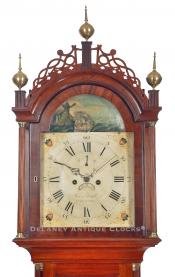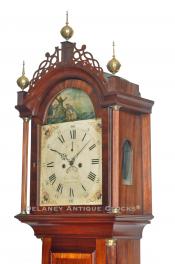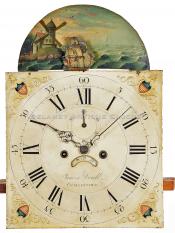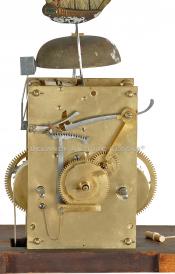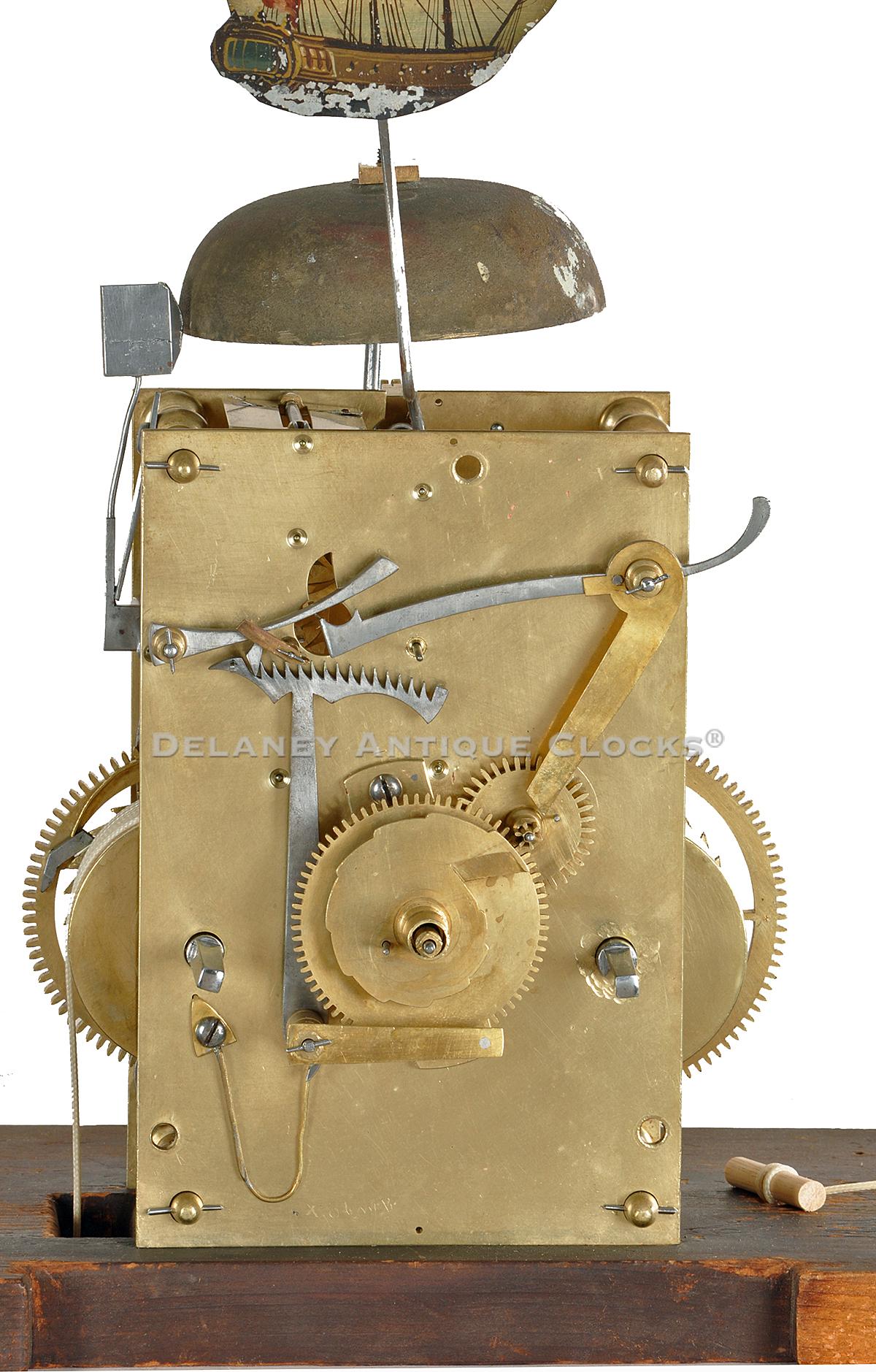James Doull tall clock. Charlestown, Massachusetts. Cabinetmakers John & Thomas Seymour of Charlestown. 212045.
An important Hepplewhite tall case clock with an automated rocking ship painted dial signed by James Doull of Charlestown, Massachusetts. The inlaid mahogany case is attributed to the Boston cabinetmakers John & Thomas Seymour and is pictured in John and Thomas Seymour Cabinetmakers in Boston 1794-1816, written by Vernon C. Stoneman. This clock is pictured on page 350.
The colorfully painted iron dial is of local origin and was most likely painted by the Boston artists Spencer Nolen & Samuel Curtis. Similar dials have been found with this artist’s signature signed on the back of the dial. It is interesting to note that this dial has a die-stamped Patten & Jones False Plate. One other Doull clock is known to be fitted in the same manner. Curtis & Nolen are known to have manufactured dials and false plates for this Philadelphia firm. Doull must have intercepted a couple before they were shipped. The clockmaker signs this example, “James Doull,” in script lettering below the center arbor. His working location, “Charlestown,” is written in block lettering and is positioned below the signature. In the arch of this dial, one will find the automated feature of a rocking ship. The painted ship is depicted flying the American flag and moves from side to side with the pendulum’s motion. The painted scene behind the sailing ship includes a large windmill built on a peninsula to the left and the open sea to the right. Several other sailing ships are depicted in the background. This nautical scene is painted on a convex piece of metal and adds to the visual depth of the scene. The four spandrel areas are decorated with colorfully painted American or Federal shields. Large Roman numerals indicate the hours. The five-minute markers are indicated in an Arabic-style format. A subsidiary seconds dial, and a calendar are displayed in the traditional locations.
The eight-day weight-driven movement is of good quality brass construction. This clock is designed to strike each hour on the hour on a bell mounted above the movement on a bell stand.
The construction of this inlaid mahogany case is attributed to the Seymour brothers of Boston, Massachusetts. It exhibits excellent proportions. The base proudly stands on flared French feet. Please note the subtle shaping or flare. The feet and the central drop apron are visually separated from the base by a complicated line inlay, a pattern that features pyramids along the same horizontal plane. This complex pattern is complicated to construct. The front of the base panel is veneered with a highly figured selection of mahogany. An inlaid framing of mahogany and satinwood stringing defines a cross-banded outer border. The waist is long and features a rectangular waist door. This door provides access to the case’s interior, where one will find a brass-covered pendulum bob and two red-painted tin can weights. This door is fitted with applied molding along the outer edge. The center of the door is veneered with a figured panel of mahogany, and the outer edge is cross-banded. The sides of the case are fitted with finely reeded quarter columns. These terminate in brass quarter capitals. They are elevated on satinwood stiles. The bonnet features an open fretwork design that is surmounted by three brass ball-and-spiked finials. The lower third of the fretwork is original to this clock. The lacy pattern has been restored with an appropriate design. The arched bonnet door is decoratively lined inlaid, and the opening is fitted with glass. Fully turned and reeded bonnet columns support the upper bonnet molding.
This wonderful clock was made circa 1810 and stands approximately 8 feet tall.
Inventory number 212045.
James Doull was born in Scotland in 1785 and immigrated to the United States, Boston, in 1806 at the age of 29. In 1807, he was listed in the Boston tax records as working as a journeyman working for the Boston clockmaker Aaron Willard. This suggests that he came to this country already trained and highly skilled. Because he is listed for only one year in Boston, it is assumed he moved to Charlestown shortly after this date. In 1823, Doull moved to Pennsylvania and took up residence in Philadelphia. In this city, he is listed as having several addresses over the years. In 1823, he resided at 112 High. In 1825, Doull moved to No. 3 Castle. From 1828 through 1833, he was on the southeast corner of South and Spruce. From 1835 through 1849, he was at the southeast corner of 4th and Spruce. Lastly, in 1856, Doull moved to south 4th and stayed there until 1856.
Over the years, we have owned a dozen or more tall case clocks, several shelf clocks, and a small number of timepieces made by this fine and talented clockmaker. The vast majority of the known clocks to us were of Massachusetts origin. One tall clock with the place location signed "Philadelphia" is also known. James Doull's most famous clock is in the White House Collection in Washington, DC. This clock is frequently on display in the Oval Office. It features a signed painted dial and a case that is attributed to the Seymour Brothers cabinetmaking firm.


